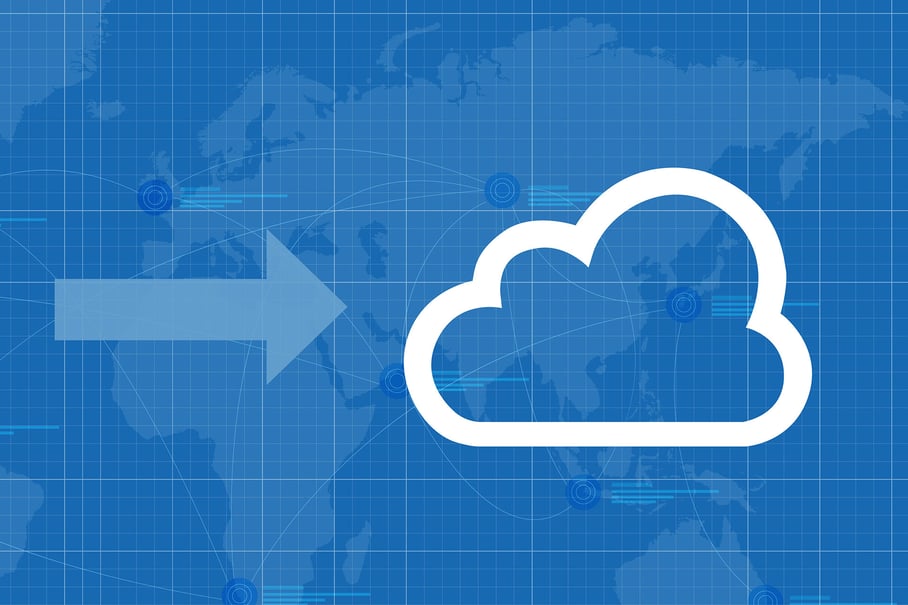
Cloud migration – moving information systems from traditional on-premises solutions to the public cloud – is an important strategic decision for many companies. In most cases, the aim of the transition is to improve business efficiency, flexibility, and reliability. In the most competitive industries, cloud migration is changing from a value-adding task to a new standard.
The popularity of cloud migration has grown significantly in recent years, driven in particular by the changing environment created by Covid. Gartner estimates that almost all new systems will be in the cloud by 2025.
Cloud migrations of existing systems are carried out for a wide variety of core business systems, depending on the industry. Common examples include ERP systems, digital commerce, IoT solutions, and product catalogs. Cloud migration is the physical transfer of a system from one capacity to another – for example, from a data center server to the public cloud. The best-known public cloud platforms are Microsoft Azure (Azure), Amazon Web Services (AWS) and Google Cloud Platform (GCP).
When is cloud migration relevant?
The timing of cloud migration is often not a very precise science, which is partly a good thing but also a challenge. Many delay the transition, firstly because it is, of course, a costly investment. Secondly, even if the cloud solution is considered superior to the traditional solution, it is difficult to translate its cost benefits into absolute euros. Thirdly, some may think that the transition is not compulsory. This is why the need for change creeps into management’s consciousness more slowly than many other investments.
As with innovation adoption in general, some are early adopters, others are in the early or late majority and the rest jump on board during the last wave. Typically, cloud migration becomes an issue at the latest when the end of the lifecycle of a company’s current, long-term software solution begins to loom, and some degree of modernization is necessary anyway. For example, data security may pose a technical threshold issue that cannot be resolved without a system overhaul.
At this type of discontinuity point, which arises naturally, a decision can be made to either migrate the current system as is to the new platform or to make other improvements to systems and working models at the same time. It is often wise to do at least some cloud transformation at the same time: when you move a system to the cloud, you are also improving and modernizing it in other ways. When the system is completely cloud-based , the service becomes cloud-native, and the full benefits of cloud computing become available.
Cloud migration brings many business benefits
Moving key information systems to the cloud delivers real business benefits in many different ways, with the best results benefiting staff, customers and other key stakeholders. Typical benefits include:
- Availability
Cloud services are fast and always available to users regardless of time and place. Continuous availability also means resilience, which is much easier to ensure in the cloud than in a traditional capacity solution
- Flexibility and scalability
A cloud-based software solution scales up and down very efficiently and dynamically. They therefore allow a company to use server capacity flexibly, depending on its needs and the prevailing situation. This helps take into account, for example, sectoral seasonal variations and peaks in demand. For example, a typical example in customer retail is Black Friday, during which a business can leverage the power of the cloud to the extent that is commercially necessary. If the company does not need the additional capacity at other times, it does not have to pay for it either.
- Dynamic pricing
The flexibility of using a cloud-based solution means that this flexibility is also reflected in the price. The company can choose where it wants to use a “pay as you go” model for capacity usage in its cloud-native solution, and where it wants to commit to a certain volume of purchases at a reduced price.
- Automation
A cloud-based software solution opens up opportunities to automate a wide range of activities, from security updates to advanced, industry-specific automation.
For example, Product Owner Riitta Kemppainen from Visma explains:
“We wanted to use the scalability and automation offered by the public cloud platform, which was not possible with the old model. In general, Visma Group also believes that the public cloud offers the best tools to ensure a good customer experience.”
--> Read more about Visma’s cloud migration path.
- Continuity
As the business situation changes and new interface needs emerge, for example, cloud solutions often offer ready-made, directly usable elements. This makes development much faster and cheaper than a traditional capacity solution.
- Latency
Although we live in a time of globalization, and information moves from place to place at an astonishing speed, geography still matters. In order to avoid the end-user experiencing unpleasant latency and jerkiness when using the software, there should not be too much geographical distance between the source data center and the user. In the public cloud, the company has access to global servers, which enables international solutions.
- Monitoring metrics
Cloud computing allows software bugs to be found and fixed faster and more comprehensively than in traditional models. At the same time, it allows better optimization of the system performance and platform utilization.
- Recruitment asset
Many companies are struggling with skills shortages and competing for the best people in the industry. Modern technical solutions are an asset when recruiting, as experts prefer to work with modern technologies.
Thanks to its many benefits, a cloud-based software solution enables a better customer experience, thus increasing customer satisfaction and loyalty. For many companies, it is ultimately the biggest business benefit of all.
Partnership pays off
There are many fundamental, strategic questions related to cloud migration: Is the transition right for our company right now? What do we want to achieve with it? How do we want to migrate – transfer the current solution as it is, partially modernize it, or turn it into a cloud-native solution? Is a private cloud or public cloud better suited to our business? And what are the differences between Microsoft Azure, Amazon Web Services and Google Cloud Platform?
The good news is that cloud migration is essentially a project like many others. The same laws of scheduling, resourcing and cost-benefit calculations also apply.
Software companies may be able to complete a cloud migration project on their own, if they have the hands and man-hours to allocate. Most of the others are supported by a partner specializing in cloud migration, as it requires relatively deep knowledge of the public cloud.
At Pinja, we are skilled and experienced cloud migration professionals. If you are considering a move to the cloud now or in the near future, please feel free to contact us – we’d be happy to help.
Read more
Pinja’s cloud services – systems, cloud and expertise working together
Cloud services in brief
What needs to be considered when modernizing systems and moving to the cloud?
Lots of talk about the cloud – three things to consider when migrating to the cloud

Tuomas Lassila
I am responsible for Pinja's ICT business. My free time is spent with family, friends and hobbies.
Back to the Pinja Blog
Categories
- Career at Pinja (68)
- Manufacturing (48)
- Knowledge Management (45)
- Production Development (44)
- Software Partnership & Tools (42)
- Sustainability (37)
- Wood and Forestry (37)
- Bioenergy and Recycling (27)
- IT Support and Outsourcing (24)
- Ecommerce (23)
- Maintenance (22)
- Artificial Intelligence and Machine Learning (15)
- Public Services (9)
- Compliance (1)